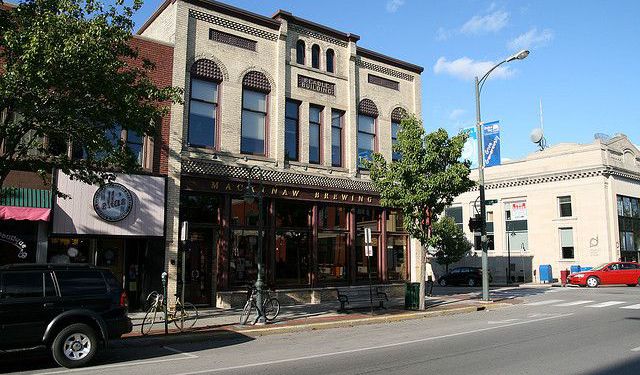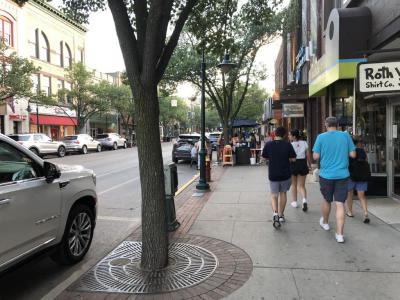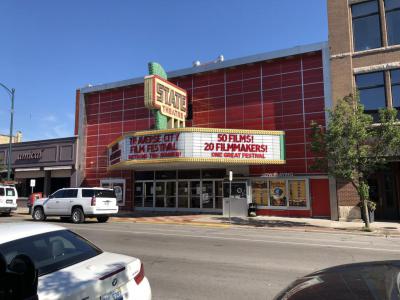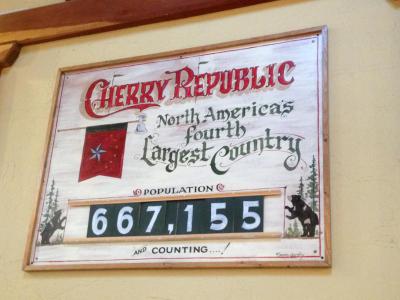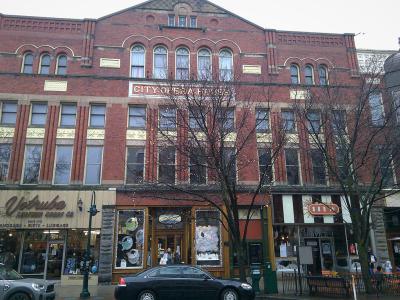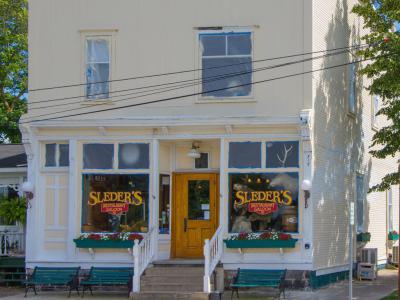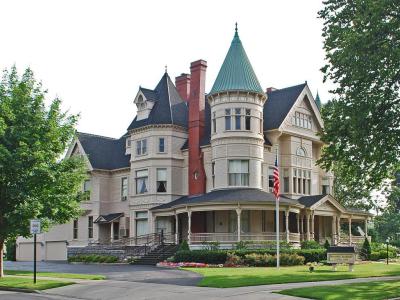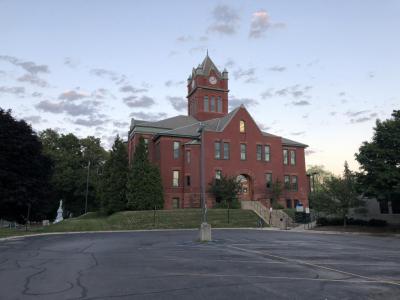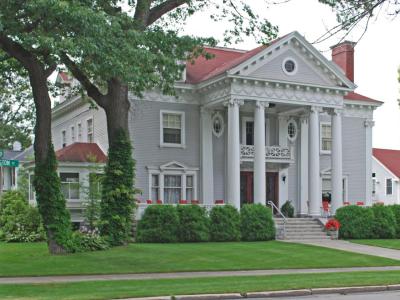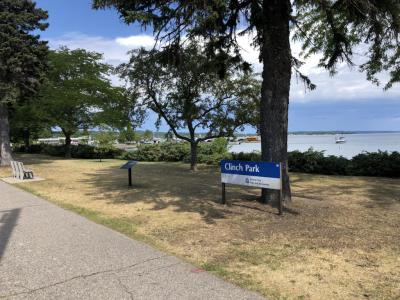Traverse City Introduction Walking Tour (Self Guided), Traverse City
Nestled along the shores of Lake Michigan's Grand Traverse Bay lies Traverse City, a charming spot rich in natural beauty. Originally inhabited by the Ojibwe and Odawa peoples, the area saw an influx of European settlers in the 18th century, drawn by its lush forests and abundant fishing grounds.
Grand Traverse Bay, named so by French voyageurs for "the long crossing" across its mouth, witnessed a transition from French and British territorial control to becoming part of the United States following the Treaty of Paris in 1783. Subsequently, the Bay's settlement was called "Grand Traverse City".
In 1853, the only post office in the region was known as "Grand Traverse". After it was moved to Grand Traverse City, to avoid confusion between the two, the settlement's name was decided to be shortened to "Traverse City".
Also around that time, the first cherry trees were planted on the Old Mission Peninsula, now famous for its cherry production. Presently, Traverse City – nicknamed the "Cherry Capital of the World" – hosts the National Cherry Festival, drawing annually half a million visitors. Initially held in the spring of 1925 to coincide with the blooming season, it now takes place in the summer, seeing the city's population rise 30-fold(!!!) during the festival week.
The arrival of rail service in 1872 transformed Traverse City and ultimately led to its incorporation in 1895. The new rail lines served, among other purposes, the influx of tourists.
Today, Traverse City retains its small-town charm while offering a vibrant cultural scene and stunning outdoor recreational opportunities. Its downtown area, centered around Front Street, is lined with boutique shops, cozy cafes, and historic buildings. Among the local architectural gems are the City Opera House, Perry Hannah House, and Wellington Inn, all meticulously restored to their former glory.
Front Street is the heart of the city, offering restaurants, cafes, boutique shops, bookstores, and entertainment. For those seeking outdoor adventures, Clinch Park beckons with its sandy beaches, scenic walking trails, and panoramic views of the Bay.
These and other attractions have earned Traverse City its reputation as a beloved destination in Northern Michigan. To see if it's well deserved, plan a trip to Traverse City and discover the charm and beauty of this enchanting lakeside place for yourself. Chances are, your Traverse City experience will prove unforgettable and will leave you longing to return again and again.
Grand Traverse Bay, named so by French voyageurs for "the long crossing" across its mouth, witnessed a transition from French and British territorial control to becoming part of the United States following the Treaty of Paris in 1783. Subsequently, the Bay's settlement was called "Grand Traverse City".
In 1853, the only post office in the region was known as "Grand Traverse". After it was moved to Grand Traverse City, to avoid confusion between the two, the settlement's name was decided to be shortened to "Traverse City".
Also around that time, the first cherry trees were planted on the Old Mission Peninsula, now famous for its cherry production. Presently, Traverse City – nicknamed the "Cherry Capital of the World" – hosts the National Cherry Festival, drawing annually half a million visitors. Initially held in the spring of 1925 to coincide with the blooming season, it now takes place in the summer, seeing the city's population rise 30-fold(!!!) during the festival week.
The arrival of rail service in 1872 transformed Traverse City and ultimately led to its incorporation in 1895. The new rail lines served, among other purposes, the influx of tourists.
Today, Traverse City retains its small-town charm while offering a vibrant cultural scene and stunning outdoor recreational opportunities. Its downtown area, centered around Front Street, is lined with boutique shops, cozy cafes, and historic buildings. Among the local architectural gems are the City Opera House, Perry Hannah House, and Wellington Inn, all meticulously restored to their former glory.
Front Street is the heart of the city, offering restaurants, cafes, boutique shops, bookstores, and entertainment. For those seeking outdoor adventures, Clinch Park beckons with its sandy beaches, scenic walking trails, and panoramic views of the Bay.
These and other attractions have earned Traverse City its reputation as a beloved destination in Northern Michigan. To see if it's well deserved, plan a trip to Traverse City and discover the charm and beauty of this enchanting lakeside place for yourself. Chances are, your Traverse City experience will prove unforgettable and will leave you longing to return again and again.
How it works: Download the app "GPSmyCity: Walks in 1K+ Cities" from Apple App Store or Google Play Store to your mobile phone or tablet. The app turns your mobile device into a personal tour guide and its built-in GPS navigation functions guide you from one tour stop to next. The app works offline, so no data plan is needed when traveling abroad.
Traverse City Introduction Walking Tour Map
Guide Name: Traverse City Introduction Walking Tour
Guide Location: USA » Traverse City (See other walking tours in Traverse City)
Guide Type: Self-guided Walking Tour (Sightseeing)
# of Attractions: 9
Tour Duration: 2 Hour(s)
Travel Distance: 3.3 Km or 2.1 Miles
Author: jenny
Sight(s) Featured in This Guide:
Guide Location: USA » Traverse City (See other walking tours in Traverse City)
Guide Type: Self-guided Walking Tour (Sightseeing)
# of Attractions: 9
Tour Duration: 2 Hour(s)
Travel Distance: 3.3 Km or 2.1 Miles
Author: jenny
Sight(s) Featured in This Guide:
- Front Street
- State Theatre
- Cherry Republic Store
- City Opera House
- Sleder’s Family Tavern
- Perry Hannah House and Central Historic District
- Grand Traverse County Courthouse
- Wellington Inn and Boardman Historic District
- Clinch Park
1) Front Street (must see)
Front Street stands as the quintessential destination within Traverse City, offering an unparalleled experience that captures the essence of this beloved northern Michigan resort community. Situated along the picturesque Boardman River, the street boasts a charming blend of natural beauty and historic charm. Visitors are greeted by the sight of the Victorian-era opera house, a testament to the city's rich architectural heritage.
One of the defining features of Front Street is its inviting ambiance, characterized by generous sidewalks adorned with benches and shade trees. These pedestrian-friendly walkways, spanning 12 to 14 feet in width, provide ample space for leisurely strolls and outdoor seating, inviting residents and visitors alike to linger and soak in the scenic surroundings. The Jay Smith Walkway pocket park offers a tranquil retreat amidst the hustle and bustle of the city, providing a serene oasis where visitors can unwind and admire the beauty of the river.
Front Street boasts the city's highest density of stores and businesses, making it a vibrant hub of activity and commerce. From charming boutiques and artisanal shops to bustling cafes and eateries, the street offers a diverse array of retail and dining options to suit every taste and preference. Additionally, Front Street plays host to numerous festivals and special events throughout the year, drawing crowds of hundreds of thousands of people. These lively gatherings add to the street's dynamic atmosphere, infusing it with energy and excitement as visitors come together to celebrate the community's vibrant culture and heritage.
One of the defining features of Front Street is its inviting ambiance, characterized by generous sidewalks adorned with benches and shade trees. These pedestrian-friendly walkways, spanning 12 to 14 feet in width, provide ample space for leisurely strolls and outdoor seating, inviting residents and visitors alike to linger and soak in the scenic surroundings. The Jay Smith Walkway pocket park offers a tranquil retreat amidst the hustle and bustle of the city, providing a serene oasis where visitors can unwind and admire the beauty of the river.
Front Street boasts the city's highest density of stores and businesses, making it a vibrant hub of activity and commerce. From charming boutiques and artisanal shops to bustling cafes and eateries, the street offers a diverse array of retail and dining options to suit every taste and preference. Additionally, Front Street plays host to numerous festivals and special events throughout the year, drawing crowds of hundreds of thousands of people. These lively gatherings add to the street's dynamic atmosphere, infusing it with energy and excitement as visitors come together to celebrate the community's vibrant culture and heritage.
2) State Theatre
Located in the heart of downtown Traverse City, the State Theatre is a cornerstone of the city’s cultural and cinematic life. Originally built in 1918 and rebuilt in 1923 after a fire, the theater began its modern history under the name Lyric Theatre, famously screening Northern Michigan’s first talking film in 1929. Over the decades, the site saw multiple iterations-each shaped by fire, restoration, and changing times. The current State Theatre structure opened in 1949 and served as a first-run movie house until 1996.
After years of vacancy and uncertain proposals, the turning point came in 2005 when the Traverse City Film Festival adopted the venue as its home. With support from filmmaker Michael Moore and the Grand Traverse Rotary, the theater underwent a sweeping restoration effort, powered by generous donations and hundreds of volunteer hours. The result was a fully transformed art house cinema, reborn with modern amenities and a design nod to classic “atmospheric” movie palaces.
The State Theatre officially reopened to the public on November 17, 2007, offering a year-round program of independent, international, and classic films, along with live performances and community events. Operated by the Traverse City Film Festival, the venue continues to serve as both a cinematic institution and a lively arts center. Its marquee lights and retro charm have made it a beloved gathering place for locals and visitors, anchoring East Front Street as a destination for film, culture, and shared experience.
After years of vacancy and uncertain proposals, the turning point came in 2005 when the Traverse City Film Festival adopted the venue as its home. With support from filmmaker Michael Moore and the Grand Traverse Rotary, the theater underwent a sweeping restoration effort, powered by generous donations and hundreds of volunteer hours. The result was a fully transformed art house cinema, reborn with modern amenities and a design nod to classic “atmospheric” movie palaces.
The State Theatre officially reopened to the public on November 17, 2007, offering a year-round program of independent, international, and classic films, along with live performances and community events. Operated by the Traverse City Film Festival, the venue continues to serve as both a cinematic institution and a lively arts center. Its marquee lights and retro charm have made it a beloved gathering place for locals and visitors, anchoring East Front Street as a destination for film, culture, and shared experience.
3) Cherry Republic Store
Nestled in the heart of Traverse City, the Cherry Republic Store stands as a delightful homage to the region's renowned cherry heritage. Traverse City, known as the "Cherry Capital of the World," boasts a rich agricultural landscape that produces 40 percent of the annual tart cherry crop in the United States. Founded in 1989 by Bob Sutherland, the Cherry Republic Store celebrates this abundant cherry harvest with a delightful array of cherry-inspired products.
Bob's journey began with selling Cherry Republic T-shirts out of the trunk of his car, featuring the motto "Life, Liberty, Beaches and Pie." Encouraged by the success of his shirts, he ventured into creating cherry-inspired treats, including the now-famous Original Cherry Boomchunka cookie. Despite facing initial challenges, Bob's dedication and passion for cherries propelled his business forward, eventually leading to the establishment of the Cherry Republic Flagship store in downtown Traverse City in 2007.
Today, the Cherry Republic Store offers a wide selection of cherry-infused delights, including jams, preserves, chocolates, and pies, all crafted with the finest local cherries. With its warm and inviting atmosphere, complete with natural wood accents and generous sample stations, the store provides visitors with a true taste of Traverse City's cherry-centric culture. Whether you're a local resident or a tourist exploring the area, a visit to the Cherry Republic Store promises a delightful journey through the flavors and traditions of Michigan's Cherry Capital.
Bob's journey began with selling Cherry Republic T-shirts out of the trunk of his car, featuring the motto "Life, Liberty, Beaches and Pie." Encouraged by the success of his shirts, he ventured into creating cherry-inspired treats, including the now-famous Original Cherry Boomchunka cookie. Despite facing initial challenges, Bob's dedication and passion for cherries propelled his business forward, eventually leading to the establishment of the Cherry Republic Flagship store in downtown Traverse City in 2007.
Today, the Cherry Republic Store offers a wide selection of cherry-infused delights, including jams, preserves, chocolates, and pies, all crafted with the finest local cherries. With its warm and inviting atmosphere, complete with natural wood accents and generous sample stations, the store provides visitors with a true taste of Traverse City's cherry-centric culture. Whether you're a local resident or a tourist exploring the area, a visit to the Cherry Republic Store promises a delightful journey through the flavors and traditions of Michigan's Cherry Capital.
4) City Opera House (must see)
Dating back to 1891, the City Opera House holds the distinction of being the first building in the city to be illuminated by electric lights, a pioneering feat that underscored its significance as a cultural and social hub in the community. Throughout its illustrious past, the opera house served as a prestigious venue for a diverse array of events, including balls, concerts, plays, and important meetings, attracting esteemed guests and dignitaries.
Despite ceasing operations in 1920, the City Opera House underwent a meticulous restoration process to preserve its historic charm and revive its role as a focal point for cultural enrichment. Today, the opera house continues to play a vital role in the community, hosting a variety of events ranging from dances and meetings to opera performances. Its multifunctional spaces, including a stunning main ballroom adorned with beautiful wood floors and high ceilings, provide an elegant backdrop for special occasions such as weddings and receptions.
The Victorian-style architecture of the City Opera House, crafted by three brothers-in-law, exudes timeless elegance and sophistication. With a seating capacity of around 1200, the opera house offers ample space to accommodate large audiences while maintaining an intimate atmosphere. Modern amenities such as air-conditioning systems, seamlessly integrated during the restoration process, ensure comfort and convenience for patrons attending events throughout the year.
Despite ceasing operations in 1920, the City Opera House underwent a meticulous restoration process to preserve its historic charm and revive its role as a focal point for cultural enrichment. Today, the opera house continues to play a vital role in the community, hosting a variety of events ranging from dances and meetings to opera performances. Its multifunctional spaces, including a stunning main ballroom adorned with beautiful wood floors and high ceilings, provide an elegant backdrop for special occasions such as weddings and receptions.
The Victorian-style architecture of the City Opera House, crafted by three brothers-in-law, exudes timeless elegance and sophistication. With a seating capacity of around 1200, the opera house offers ample space to accommodate large audiences while maintaining an intimate atmosphere. Modern amenities such as air-conditioning systems, seamlessly integrated during the restoration process, ensure comfort and convenience for patrons attending events throughout the year.
5) Sleder’s Family Tavern
Since 1882, Sleder’s Family Tavern has been an iconic fixture in Traverse City, standing as the state’s oldest continuously operated restaurant. Founded by Vencil Sleder, an immigrant from Bohemia, the tavern originated in Slabtown, a working-class neighborhood on the west side of Traverse City. Vencil envisioned a welcoming space where hardworking individuals could unwind and enjoy hearty meals after a long day. With the help of his neighbors, he constructed the tavern using wooden slabs sourced from nearby sawmills, laying the foundation for a legacy that would span generations.
Stepping into Sleder’s today is like taking a journey back in time, with original features such as the slab flooring and stamped tin ceiling preserving the tavern’s historic charm. The atmosphere is warm and inviting, adorned with parlor chairs, a mahogany bar, cozy booths, and vintage photographs that tell the story of its rich heritage. Whether you’re seeking a casual lunch with family or a romantic dinner for two, Sleder’s offers an intimate setting where meaningful conversations unfold over delicious meals.
At Sleder’s, the menu reflects a commitment to tradition and quality, with a diverse selection of American classics prepared using locally sourced ingredients. From their renowned Bean Soup to hand-pattied beef and buffalo burgers, every dish is crafted with care and served with pride. As evening falls, the tavern comes alive with the sizzle of Slabtown Ribs, Cherry Barbequed Chicken, and other mouthwatering specialties.
Pair your meal with a refreshing pint of Sleder’s Cream Ale or choose from their extensive beer and wine menu, featuring local favorites and seasonal selections. With friendly service, rustic ambiance, and a menu that caters to every taste, Sleder’s Family Tavern remains a beloved destination where memories are made and traditions endure.
Stepping into Sleder’s today is like taking a journey back in time, with original features such as the slab flooring and stamped tin ceiling preserving the tavern’s historic charm. The atmosphere is warm and inviting, adorned with parlor chairs, a mahogany bar, cozy booths, and vintage photographs that tell the story of its rich heritage. Whether you’re seeking a casual lunch with family or a romantic dinner for two, Sleder’s offers an intimate setting where meaningful conversations unfold over delicious meals.
At Sleder’s, the menu reflects a commitment to tradition and quality, with a diverse selection of American classics prepared using locally sourced ingredients. From their renowned Bean Soup to hand-pattied beef and buffalo burgers, every dish is crafted with care and served with pride. As evening falls, the tavern comes alive with the sizzle of Slabtown Ribs, Cherry Barbequed Chicken, and other mouthwatering specialties.
Pair your meal with a refreshing pint of Sleder’s Cream Ale or choose from their extensive beer and wine menu, featuring local favorites and seasonal selections. With friendly service, rustic ambiance, and a menu that caters to every taste, Sleder’s Family Tavern remains a beloved destination where memories are made and traditions endure.
6) Perry Hannah House and Central Historic District
The Central Neighborhood Historic District offers a glimpse into the past with its collection of residential structures. Established in 1979 and occupying a footprint defined by 5th, Union, 9th, and Division Streets, this district encompasses 459 buildings, showcasing the area's rich heritage. Originating around the turn of the 20th century, the Central Neighborhood flourished during a period marked by the construction of its iconic homes, with the bulk erected between 1890 and 1914. Notable figures like lumber magnate Perry Hannah, along with other prominent residents such as John Morgan and Cuyler Germaine, shaped the fabric of this community.
The district is predominantly residential, boasting 407 single-family homes, along with 44 outbuildings and eight churches and schools. Architectural styles range from vernacular interpretations of Queen Anne and Italianate to Neo-Georgian designs, reflecting the evolving tastes of its residents over time.
The Perry Hannah House, also known as the Reynolds-Jonkhoff Funeral Home, was built in 1893 by Grand Rapids architect William G. Robinson for Perry Hannah, a prominent figure in Traverse City's development. Originally serving as Hannah's retirement residence until his passing in 1904, the house underwent several ownership changes over the years. It was nearly demolished by Hannah's daughter-in-law due to financial constraints but was saved and repurposed as a funeral home. Despite its transformation, the original character of the house remains largely intact.
Situated on a spacious corner lot, the Perry Hannah House boasts a distinctive Queen Anne architectural style, characterized by its asymmetrical design, round corner turrets, and expansive veranda. Inside, the house impresses with its sprawling layout, encompassing 40 rooms spread across four floors. The interior showcases exquisite craftsmanship, with intricate woodwork featuring a variety of premium woods such as cherry, oak, walnut, and Brazilian mahogany. Noteworthy features include ten fireplaces adorned with handmade Venetian tiles, adding to the house's charm and historical allure.
Today, the Reynolds-Jonkhoff Funeral Home continues to operate within the Perry Hannah House, preserving its rich heritage while providing essential services to the community. As a designated Michigan State Historic Site and listed on the National Register of Historic Places, the Perry Hannah House stands as a tangible link to Traverse City's past and a testament to the vision and achievements of Perry Hannah.
The district is predominantly residential, boasting 407 single-family homes, along with 44 outbuildings and eight churches and schools. Architectural styles range from vernacular interpretations of Queen Anne and Italianate to Neo-Georgian designs, reflecting the evolving tastes of its residents over time.
The Perry Hannah House, also known as the Reynolds-Jonkhoff Funeral Home, was built in 1893 by Grand Rapids architect William G. Robinson for Perry Hannah, a prominent figure in Traverse City's development. Originally serving as Hannah's retirement residence until his passing in 1904, the house underwent several ownership changes over the years. It was nearly demolished by Hannah's daughter-in-law due to financial constraints but was saved and repurposed as a funeral home. Despite its transformation, the original character of the house remains largely intact.
Situated on a spacious corner lot, the Perry Hannah House boasts a distinctive Queen Anne architectural style, characterized by its asymmetrical design, round corner turrets, and expansive veranda. Inside, the house impresses with its sprawling layout, encompassing 40 rooms spread across four floors. The interior showcases exquisite craftsmanship, with intricate woodwork featuring a variety of premium woods such as cherry, oak, walnut, and Brazilian mahogany. Noteworthy features include ten fireplaces adorned with handmade Venetian tiles, adding to the house's charm and historical allure.
Today, the Reynolds-Jonkhoff Funeral Home continues to operate within the Perry Hannah House, preserving its rich heritage while providing essential services to the community. As a designated Michigan State Historic Site and listed on the National Register of Historic Places, the Perry Hannah House stands as a tangible link to Traverse City's past and a testament to the vision and achievements of Perry Hannah.
7) Grand Traverse County Courthouse
The Grand Traverse County Courthouse, a distinguished example of Richardsonian Romanesque architecture, commands attention in courthouse square, proudly situated atop the city's highest ground. Its striking red brick and sandstone facade, adorned with intricate detailing, evokes a sense of grandeur and permanence. Rising from the courthouse's roof is a majestic clock tower, a prominent feature that adds to its imposing presence. Adjacent to the courthouse once stood the county jail and sheriff's residence, constructed in 1882–1883, further enhancing the historical significance of the site.
The courthouse's origins trace back to the mid-19th century when the first county buildings were erected on land generously donated by Hannah, Lay, and Company. Unfortunately, a devastating fire in 1862 destroyed these structures, leading to the need for a new courthouse. The Grand Traverse County Board of Supervisors selected plans drafted by Rush, Bowman, and Rush of Grand Rapids, envisioning a building that would stand as a testament to the county's growth and progress. However, disagreements over costs between the board and the original architects and contractors caused delays in construction, prompting the board to enlist the expertise of Cassius M. Prall to oversee the project.
Despite initial setbacks, the Grand Traverse County Courthouse eventually rose to prominence as a symbol of justice and civic pride. Its enduring legacy endured through the decades, with renovations in 1979–1981 repurposing the courthouse to accommodate district and circuit courts following the construction of a new city-county governmental center nearby. Today, the courthouse stands as a cherished landmark, serving as a reminder of the county's rich history and ongoing commitment to the principles of law and governance.
The courthouse's origins trace back to the mid-19th century when the first county buildings were erected on land generously donated by Hannah, Lay, and Company. Unfortunately, a devastating fire in 1862 destroyed these structures, leading to the need for a new courthouse. The Grand Traverse County Board of Supervisors selected plans drafted by Rush, Bowman, and Rush of Grand Rapids, envisioning a building that would stand as a testament to the county's growth and progress. However, disagreements over costs between the board and the original architects and contractors caused delays in construction, prompting the board to enlist the expertise of Cassius M. Prall to oversee the project.
Despite initial setbacks, the Grand Traverse County Courthouse eventually rose to prominence as a symbol of justice and civic pride. Its enduring legacy endured through the decades, with renovations in 1979–1981 repurposing the courthouse to accommodate district and circuit courts following the construction of a new city-county governmental center nearby. Today, the courthouse stands as a cherished landmark, serving as a reminder of the county's rich history and ongoing commitment to the principles of law and governance.
8) Wellington Inn and Boardman Historic District
The Boardman Neighborhood Historic District is a residential area with significant historical value. Established during Traverse City's early lumber boom, this district boasts a rich heritage dating back to the late 19th century. The neighborhood was home to prominent figures such as Captain Henry Boardman, the Havilands, and the Hulls, who built grand houses reflecting the prosperity of the era. Over time, the area experienced fluctuations, with a decline in the 1920s followed by a resurgence in the 1970s that restored its single-family character.
Today, the district comprises around 174 well-preserved structures, predominantly Victorian-style homes constructed with clapboard siding. These residences, ranging from opulent estates to more modest dwellings, showcase the diverse socioeconomic backgrounds of its original inhabitants. While primarily residential, the district also features some nonresidential buildings, including the city's first general hospital.
The Wellington Inn stands as a striking example of Academic Classicism architecture. Its grand façade is adorned with a pedimented portico supported by paired giant Ionic columns, creating an imposing entrance that commands attention. The meticulous attention to detail is evident in the Ionic corner pilasters, ornate cornice featuring swags, modillioned eaves line, and a carved swag embellishing the entrance, all of which contribute to the house's stately appearance. Originally constructed for the son of the president of the Oval Wood Dish Company and his family, the Wellington Inn has retained its status as the neighborhood's most impressive residence.
Throughout its history, the Wellington Inn has undergone several transformations. In 1929, the Hull family converted the house into four separate apartments, reflecting changing times and lifestyles. However, in 1999, Barb and Hank Rishel recognized the historical significance of the property and embarked on a meticulous restoration project. Their vision was to revive the Wellington Inn's former glory and transform it into a charming bed-and-breakfast establishment, paying homage to its rich heritage. After extensive restoration work, the Wellington Inn opened its doors as a bed-and-breakfast in 2003, welcoming guests to experience the elegance and refinement of a bygone era.
Today, the Wellington Inn stands as a testament to the dedication and passion of its owners, who have preserved its architectural splendor for future generations to enjoy. Every corner of the inn is adorned with period antiques, from the guest rooms and dining room to the library and living room, creating an atmosphere of old-world charm and sophistication. The inn evokes a sense of nostalgia for an era when families gathered for intimate gatherings at home, and leisurely strolls through the neighborhood led to downtown shops, restaurants, and beaches just a couple of blocks away.
Today, the district comprises around 174 well-preserved structures, predominantly Victorian-style homes constructed with clapboard siding. These residences, ranging from opulent estates to more modest dwellings, showcase the diverse socioeconomic backgrounds of its original inhabitants. While primarily residential, the district also features some nonresidential buildings, including the city's first general hospital.
The Wellington Inn stands as a striking example of Academic Classicism architecture. Its grand façade is adorned with a pedimented portico supported by paired giant Ionic columns, creating an imposing entrance that commands attention. The meticulous attention to detail is evident in the Ionic corner pilasters, ornate cornice featuring swags, modillioned eaves line, and a carved swag embellishing the entrance, all of which contribute to the house's stately appearance. Originally constructed for the son of the president of the Oval Wood Dish Company and his family, the Wellington Inn has retained its status as the neighborhood's most impressive residence.
Throughout its history, the Wellington Inn has undergone several transformations. In 1929, the Hull family converted the house into four separate apartments, reflecting changing times and lifestyles. However, in 1999, Barb and Hank Rishel recognized the historical significance of the property and embarked on a meticulous restoration project. Their vision was to revive the Wellington Inn's former glory and transform it into a charming bed-and-breakfast establishment, paying homage to its rich heritage. After extensive restoration work, the Wellington Inn opened its doors as a bed-and-breakfast in 2003, welcoming guests to experience the elegance and refinement of a bygone era.
Today, the Wellington Inn stands as a testament to the dedication and passion of its owners, who have preserved its architectural splendor for future generations to enjoy. Every corner of the inn is adorned with period antiques, from the guest rooms and dining room to the library and living room, creating an atmosphere of old-world charm and sophistication. The inn evokes a sense of nostalgia for an era when families gathered for intimate gatherings at home, and leisurely strolls through the neighborhood led to downtown shops, restaurants, and beaches just a couple of blocks away.
9) Clinch Park (must see)
Clinch Park is a picturesque recreation venue that beckons both locals and tourists alike. Boasting scenic views of the nearby beach and Grand Traverse Bay, the park offers an idyllic setting for leisurely strolls, invigorating runs, or simply basking in the beauty of nature. Its central location within the city makes it easily accessible and highly frequented, serving as a popular gathering spot for individuals and families seeking relaxation and outdoor enjoyment.
The park's expansive beach area is a major draw, attracting visitors with its soft sands and tranquil waters. Whether lounging on the shore or indulging in water activities, such as swimming or paddleboarding, visitors can immerse themselves in the serene ambiance of the bay. Additionally, the park's well-maintained pathways provide the perfect backdrop for leisurely walks, offering panoramic vistas of the surrounding landscape and opportunities for peaceful reflection.
Clinch Park is not only a haven for outdoor enthusiasts but also a vibrant hub of community activity. Weekends come alive with organized concerts and celebrations, creating a lively atmosphere that fosters camaraderie and fun. Families often gather for picnics amidst the park's lush greenery, enjoying quality time together amidst the natural beauty.
The park's expansive beach area is a major draw, attracting visitors with its soft sands and tranquil waters. Whether lounging on the shore or indulging in water activities, such as swimming or paddleboarding, visitors can immerse themselves in the serene ambiance of the bay. Additionally, the park's well-maintained pathways provide the perfect backdrop for leisurely walks, offering panoramic vistas of the surrounding landscape and opportunities for peaceful reflection.
Clinch Park is not only a haven for outdoor enthusiasts but also a vibrant hub of community activity. Weekends come alive with organized concerts and celebrations, creating a lively atmosphere that fosters camaraderie and fun. Families often gather for picnics amidst the park's lush greenery, enjoying quality time together amidst the natural beauty.
The Most Popular Cities
/ view all
